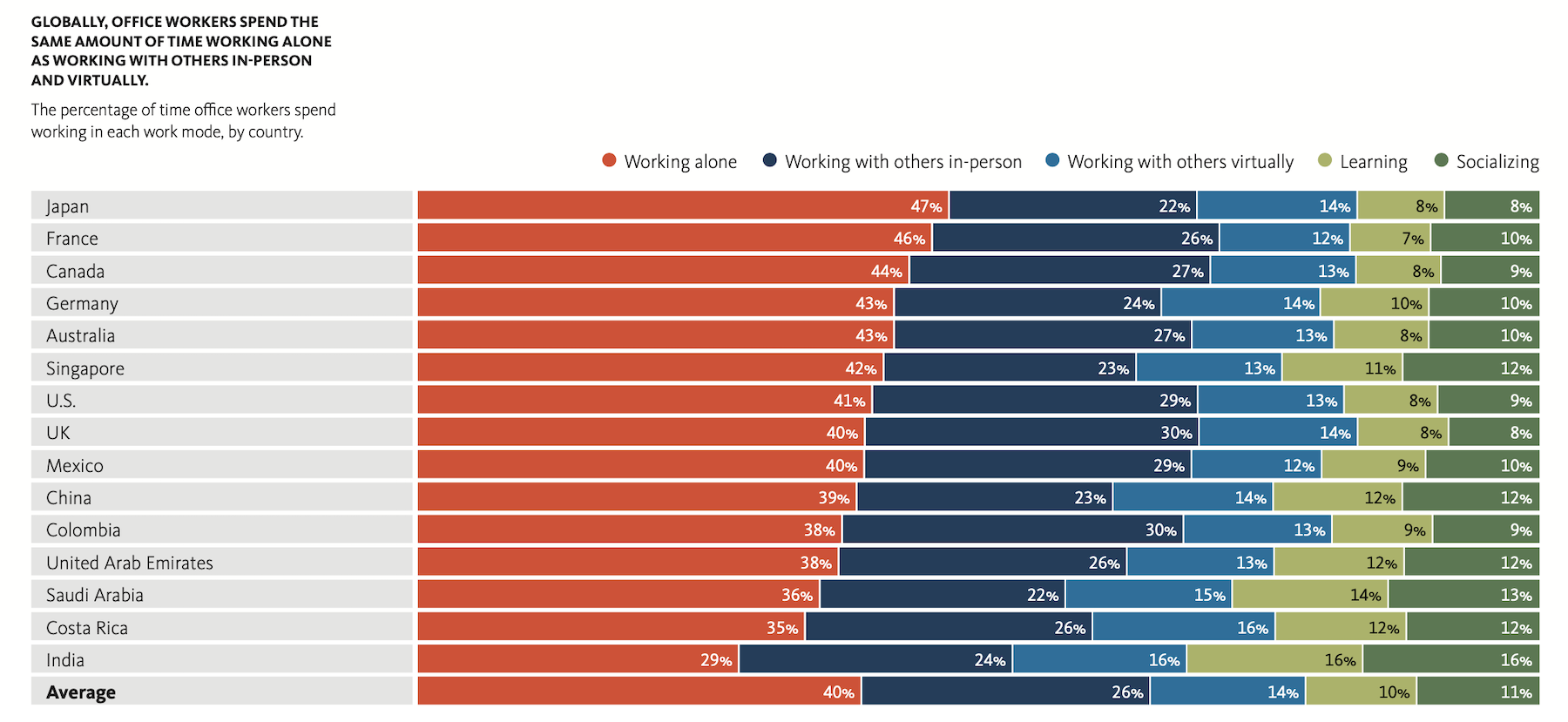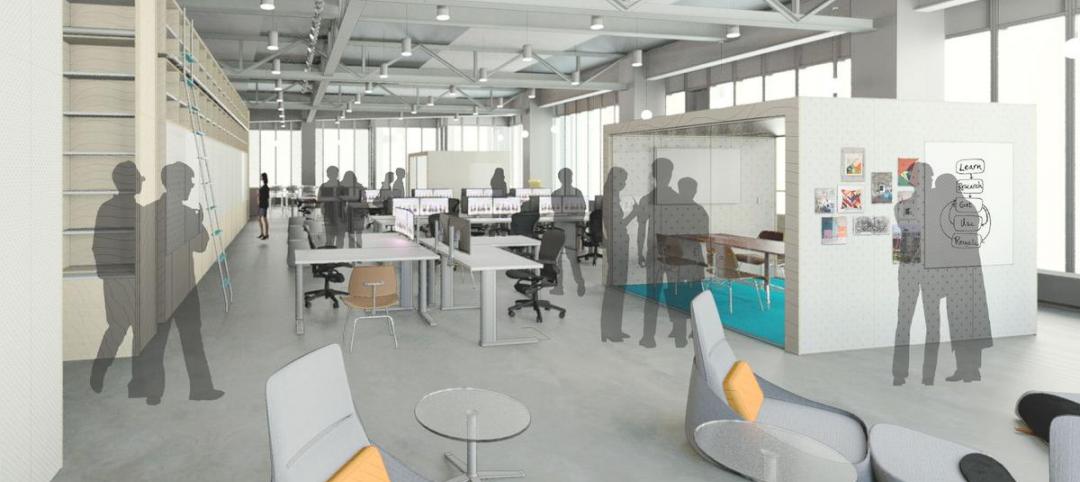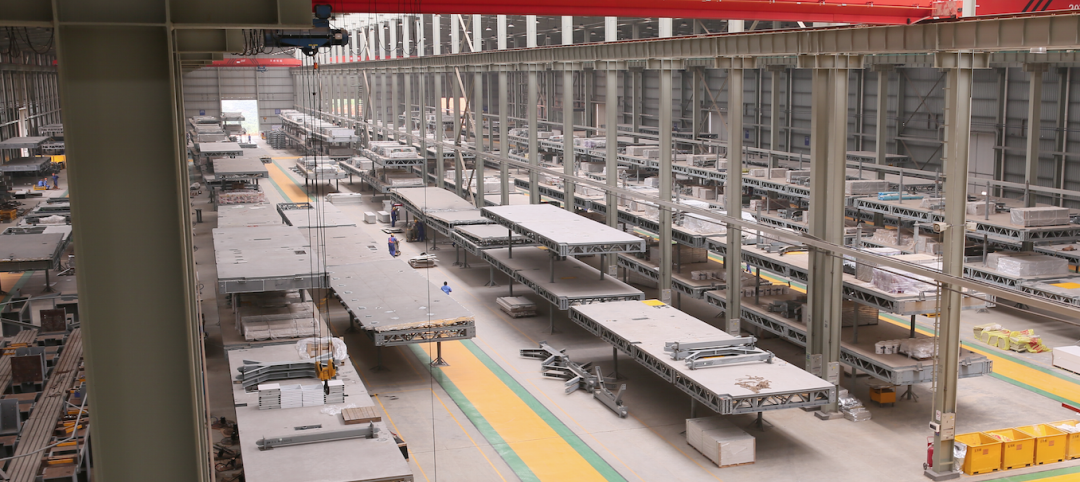For years, AEC firms and their developer clients have worked under the assumption that a good workplace is effective when it fosters working alone, with others in-person and virtually, learning, and socializing.
These factors are foundational as workplace performance indicators. “But having a good workplace is no longer enough,” states The Gensler Research Institute in its Global Workplace Report 2024, which is based on over 16,000 employee responses to a survey conducted in 15 countries and with 10 client industries. (The survey, conducted from October 2023 to January 2024, did not include fulltime remote workers.)
The report contends that employees are seeking different experiences that go beyond functional and effective office spaces, and now include feeling that the space is beautiful, welcoming, and inspires thinking. Within the office, spaces with the greatest impact on performance are innovation hubs, cafés, outdoor areas, and “focus” rooms. Beyond the building itself, exceptional workplaces leverage their surrounding neighborhoods’ amenities and services.
Gensler’s research shows, however, that many workplaces across industries and countries lag in the quality of their workplace experiences.

High-performing employees have more workplace choices
Gensler’s latest study highlights the shift, in gauging an office’s effectiveness, from real estate occupancy to people-centric performance measures, to assess the design impact on how employees work and feel in the workplace, individually, in teams, and as part of a company.

The report defines workplace performance as an average of two composite scores that measure how space supports work and how employees feel about that space. Effectiveness measures factors such as function, layout, and so forth; experience measures factors such as beauty and inspirational feelings.
Global office workers spend half of their typical workweeks in the workplace, 20% of their time at home, and 29% in other locations that might include coworking space. Pre-pandemic, this average was closer to 70% of time in the office. “Now, more than ever, the workplace needs to respond to a wider offering of spaces and experiences,” states the report, adding that employees across the world have unique and individual needs within the office.
The report looks closer at how top performing employees are experiencing their workplaces. The report scores the most-engaged individuals on factors such as how energized and happy they feel while working. Employees with the highest engagement score differ from other workers in the amount of time they spend working alone, learning, and socializing. (The report finds that these employees spend just 36% of their time working alone, versus 44% among the least-engaged employees.)

Nearly all top performers—96%––also say they have control over how they manage their time, versus half of those working in low-performing offices. Gensler emphasizes that “exceptional” workplaces offer their employees choices about where they work within the office. High-performing workplaces offer greater access to spaces for critical work activities, and overall have more work settings to choose from. This empowers the employees to work at the most effective spaces for their tasks.
It's not all about work, either. More than 90% of employees in high-performing workplaces says the office allows them to occasionally unplug from technology. And these workers also tend to use the office more for socializing and having fun.
Amenities add to workplace’s cache
Two-thirds of the workers surveyed describe their company’s office building as “one of the premium, higher-quality” commercial buildings in their areas. Gensler contends that building quality has a direct relationship to workplace quality: high-performing workplaces are twice as likely to be inside high-quality office buildings. These buildings, as often as not, are located in neighborhoods that offer diverse amenities, services, and alternate workspaces. High-performing workplaces, estimates Gensler, have access to 2.6-times as many amenity spaces on-site and 1.6-times as many amenities and services in the neighborhood. “Access to amenities and services appears to make a particular difference,” Gensler states about such “ecosystems” of spaces and experiences.

However, the report also finds that less than one-third of workplaces globally has been redesigned in the last three year, making these workplaces less likely to be able to meet the expectations of young people entering the workforce. “There’s a pressing need for organizations to intentionally rethink office spaces to boost company culture and drive business growth,” says Gensler.
Janet Pogue McLaurin, Gensler’s Global Director of Workplace Research, observes that a great workplace “must not only be a tool to get work done effectively but be intentionally designed for human emotion,” creating experiences that support new ways to work in and outside of the office.
Related Stories
Office Buildings | Mar 2, 2016
HDR redesigns Twin Cities' studio to have coffee shop vibe
With open spaces, huddle rooms, and a design lab, the firm's new digs are drastically different than the old studio, which felt like working in a law office. Design Principal Mike Rodriguez highlights HDR's renovation plan.
Office Buildings | Mar 1, 2016
SmithGroupJJR and The Christman Company create a financial headquarters without the drab
The “un-bank” design ditched the stuffy design elements typical of financial institutions and, instead, created something much more inviting.
Office Buildings | Feb 29, 2016
Mobileapolis: An open experiment in workplace mobility
Check out this fun infographic that explains Perkins+Will's ambitions, findings, and next steps for the future home of the firm's Minneapolis office.
Office Buildings | Feb 26, 2016
Benching, desking, and (mostly) paper-free: Report identifies top trends in workplace design for 2016
The report, from Ted Moudis Associates, encompasses over 2.5 million sf of workspace built over the past two years.
Game Changers | Feb 5, 2016
Asia’s modular miracle
A prefab construction company in China built a 57-story tower in 19 days. Here’s how they did it.
Game Changers | Feb 4, 2016
GAME CHANGERS: 6 projects that rewrite the rules of commercial design and construction
BD+C’s inaugural Game Changers report highlights today’s pacesetting projects, from a prefab high-rise in China to a breakthrough research lab in the Midwest.
Mixed-Use | Jan 25, 2016
SOM unveils renderings of dual-tower Manhattan West development
The five million-sf project includes two office towers, a residential tower, retail space, and a new public square.
Office Buildings | Jan 21, 2016
Nike reveals design, first images of planned 3.2 million-sf expansion to its world headquarters
The expansion looks to combine design elements inspired by human movement, speed, and the strength and energy of competition.
| Jan 14, 2016
How to succeed with EIFS: exterior insulation and finish systems
This AIA CES Discovery course discusses the six elements of an EIFS wall assembly; common EIFS failures and how to prevent them; and EIFS and sustainability.
Office Buildings | Jan 14, 2016
JLL: Slowdown not expected for office market
The booming sector had an occupancy growth rate 1.3 times that of new supply in the fourth quarter of 2015.

















